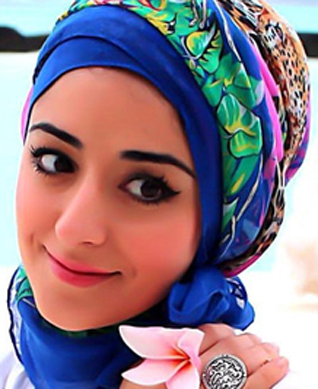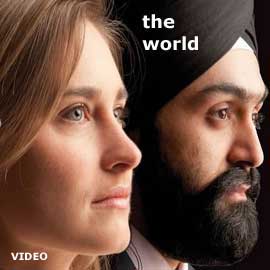Roundtable
Style Savvy Muslim Women Turn to Turbans:
The Roundtable Open Forum # 133
SHOUNAZ MEKY
Fashionable turban head covers are all the rave as women who seek to cover their hair raid their closets for stylish looks that offer an alternative to the hijab.
Once a typically male accessory, the turban is breaking the mold and is being picked up by many Muslim women across the Gulf.
“The new ways of wearing the hijab is becoming a new global phenomenon,” says Lezley George, professor of fashion at the Heriot Watt University in Dubai. It combines the desire to look Muslim and appear more fashionable, George added.
“Variation in the world of turban styling” is one reason why many girls like the trend, according to George. “What they find exciting with the headscarf in general is the way you can customize it and personalize it.”
‘PRACTICAL FOR DIFFERENT OCCASIONS’
Sara Adel, a fashion blogger and digital designer living in Dubai says that the turban-style hijab gives more head-covering options to Muslim women, especially in hot weather.
“On some days, I have to shoot outdoors and it’s a relief to wear a turban on a sunny day,” Adel said.
Like Adel, Jihad M’nasria, a Tunisian TV producer based in Dubai, said that due to the long hours she spends in the heat a turban is a practical choice.
“I do find it practical and chic,” said M’nasria.
“Personally I’ve been wearing Hijab since I was 13 years old and I’m bored of wearing it the same way over and over,” she added. “I tend not to be a routine kind of a person and hijab kind of limits you to some head-wear styles.”
Heba Ashraf, an Egyptian dentist, says that the turban style is “very practical” for celebratory occasions such as weddings.
“It is a change because we Hijabi girls sometimes get bored of looking the same all the time so we like to change it up,” Ashraf said.
Meanwhile, George said some girls like to wear the turban while travelling abroad, as it makes veiled girls look less typical and is seen by some as more fashion savvy.
IS IT MODEST ENOUGH?
While some may regard the style as a proper head cover, others argue that it cannot be considered a proper Islamic veil.
“Some consider it not modest enough because there are different types of turbans which might expose your neck,” George said.
“Some might be critical that you’re not converting sufficiently,” she said. “However, people perceive modest dressing differently.”
To those who think wearing a turban is not modest enough, Ashraf says wearing under- garments to cover up the neck and the ears can be used “if you think it is revealing.”
THE ROUNDTABLE OPEN FORUM # 133
We invite our readers to share their thoughts on the above. Do we -- Sikh men and women -- have anything to learn from the described experiences of, and by these Muslim women?
[Courtesy: Al Arabiya. Edited for sikhchic.com]
October 10, 2014
Conversation about this article
1: Kiran Kaur (Toronto, Ontario, Canada), October 10, 2014, 7:16 AM.
But for a few exceptions here and there, many of the Sikh women who wear the dastaar don't do it gracefully. It is crudely or sloppily or a little too plainly wrapped on, as if the goal is to look as less feminine as possible. This article reminds us that we have options ... there is no reason why we cannot do it with finesse and style. I even know some Jewish women who love wearing beautiful turbans, though their menfolk tend to look down on reviving this part of their otherwise beautiful heritage.
2: R P Singh (Palo Alto, California, USA), October 10, 2014, 7:30 AM.
In response to Kiran Kaur ji's statement, "as if the goal is to look as less feminine as possible." As if the turban should be a site for the expression of one's femininity? Does a shabby turban mean one is expressing their masculinity?
3: Kiran Kaur (Toronto, Ontario, Canada), October 10, 2014, 7:42 AM.
And why not, R P Singh ji? Sikhs are to live life to the fullest, in its full glory and celebration. Being feminine includes looking beautiful -- read the Guru Granth Sahib carefully and you'll find references to how a woman prepares herself to look her best! After all, Sikh men -- or at least those who practice proper grooming -- try their best to look as masculine and macho as possible. Is that what women should aspire for, or should they follow their feminine instincts? Looking shabby and disheveled is not Sikhi. For men or women. Just think about it: when we envision our Gurus in our mind's eye, don't we see them in fineries and bejeweled? All the points raised by the women above, I suggest, apply equally to males -- in furthering their masculinity. Thus, just as there is nothing wrong with Sikh men being masculine, there is absolutely nothing wrong in Sikh women celebrating their femininity.
4: Japji Kaur (New Jersey, USA), October 10, 2014, 7:49 AM.
I agree with Kiran all the way. Dressing up shabby is not masculine, it is being lazy. And, in extremes, being uncouth. Poor or rich, educated or unlettered, it requires little to be at our best. It is central to being a Sikh.
5: Inderjit Kaur (Leeds, United Kingdom), October 10, 2014, 7:53 AM.
Hey, fellas, just look at the image accompanying the article. Why can't a Sikh woman's dastaar be like that? It has the Sikh style and it even has 'Sikh colours' (not that any specific colours are essential). There is no reason in the world that a Sikh woman's dastaar has to follow the example of the male dastaar. Sikh men around the world wear their turbans in scores of different ways. The 3HO women started their own style. So ... where's the problem, mate?
6: Sarvjit Singh (Massachusetts, USA), October 10, 2014, 10:50 AM.
Good conversation. There is a thin line somewhere re Sikhi principles and looking good. There are stories where being properly attired was expected of Sikhs to look regal and asked by the Gurus. Best answer I heard was from a very old Nihang baba. It took him an hour or so to tie his huge turban and decorate it with all the sarb loh jewelry, i.e., khandas, kirpans, and other decorative karras. Meaning to dress well but with modesty, using sarb loh, not gold or silver. It all comes down to personal choice.
7: Talwinder Singh (USA), October 10, 2014, 12:02 PM.
From a Sikh point of view, we, Sardars and Sardarnis, need to understand the significance of the turban first and how it relates to us. Color or style is secondary. Agreed that importance of neatness and attractiveness should be stressed.
8: TJ Singh (Vancouver, British Columbia, Canada), October 10, 2014, 2:50 PM.
I have to agree with Kiran Kaur of Toronto, Canada. We Sikhs should be proud of our appearance and dress ourselves accordingly which exudes confidence to the world. Why shouldn't Sardarnis live up to this same standard? I see many Sardars still tie their turbans as if they worked a long day in the fields. Yet I've noticed the Sikh youth have now embraced pride in tying their turbans with style and awareness given the resurgence of Sardari in the past few years. Like it or not, every Sardar and Sardarni is looked upon and noticed in day to day life, so why not put your best foot forward and walk with pride and confidence with a smartly tied turban ...
9: Harman Singh (California, USA), October 10, 2014, 5:32 PM.
The goal of the turban is to cover one's head in humility and submission to the Lord's Will or Hukam. Whether we wrap 2 meters or 10 meters of cloth is immaterial. Sikhi allows for personal freedom and variation in practice. There is nothing wrong in wearing one's articles of faith with finesse and style.
10: Sarvjit Singh (Massachusetts, USA), October 10, 2014, 5:45 PM.
I have always worn navy, black, or very dark shades of turbans. Only recently I started wearing bright colors such as yellow, red, green and similar shades. And I got noticed and complimented each time. Also learned to pay more attention to puggh size, it should not be too big or too small, in relation to the face and head. There should be abook on Turbans with details, origins and other generic information.
11: Baldev Singh (Bradford, United Kingdom), October 11, 2014, 9:08 AM.
We wear the 'Cotton Crown' as an integral part of our identity and it gives us regal titles! Thereafter, it is up to each one of us what to make of it ... live up to the highest standards of excellence or become/remain ordinary.
12: Sangat Singh (Kuala Lumpur, Malaysia), October 11, 2014, 9:08 PM.
As a child I remember my respected 'Bhaayyia ji' (father) used to tie a pure silk cream-coloured turban. We had the pleasure of having him in the late 60's in Malaysia for a year and I noticed that he was no longer using silk but normal F 74 Malmal turban. One day he sheepisly asked: "Is 'Do Ghoray' ('Two Horses' brand) Chinese silk still available?"
13: Gurdarshan Singh (Kuala Lumpur, Malaysia), October 13, 2014, 6:27 AM.
As a practicing lawyer, my Court attire and their colour are always boringly a white shirt with black pants. However there is no restriction for the Sikhs to wear colour turbans. [Not for Muslim women, though. Their hijab must be black or white.] I wore my turbans according to the days which I called 'colour of success'. On Monday: Blue - blue turban / white 'fifty' and matching tie. Tuesday: Yellowish / Kesri. Or I wear a black turban with light yellow or kesri fifty and matching tie. On public holidays or non-court days, I will wear a kesri or yellow turban. Wednesday: Green - green Turban with white fifty and matching tie or Black turban with green fifty. Thursday: Pink / Maroon / Red. Or a black turban with light pink fifty and pink tie. It look awesome. Or a Maroon turban with white fifty and maroon tie. Friday: Purple day - purple turban with purple shirt and tie. Saturday: Black and White ... and the sun is free.
14: Sangat Singh (Kuala Lumpur, Malaysia), October 14, 2014, 7:41 AM.
#13: Wow, what a colourful wardrobe! Enough to confuse His Lordship to ask, "Where is your brother today?"
15: Simran Kaur (Nairobi, Kenya), October 14, 2014, 3:44 PM.
A number of my friends and I have had long discussions over this article and I find that some of us get stuck in the mistaken notion that style and fashion and good living are antithetical to spiritual life. Not true. What needs to be kept in mind is that living life to its max is integral to Sikhi but as an addendum to our spiritual life, not a replacement for it. The two need to go hand-in-hand, and if they do, the result is awesome -- both in the worldly and in the spiritual sense!



